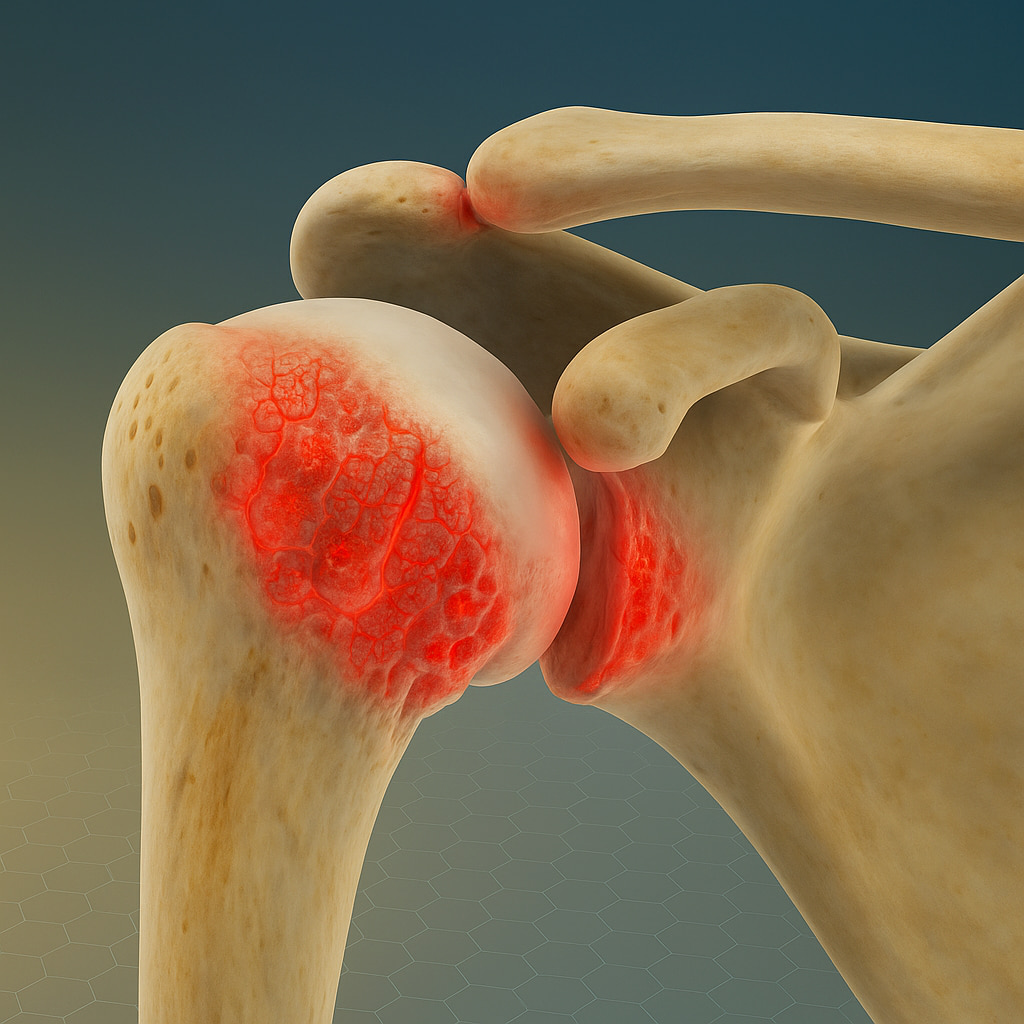Shoulder arthritis is a condition where the cartilage within the shoulder joint deteriorates. This joint comprises two main parts: the glenohumeral (ball-and-socket) joint, where the humerus (upper arm bone) meets the glenoid (shoulder blade socket), and the acromioclavicular (AC) joint, where the clavicle (collarbone) connects to the shoulder blade. For AC joint arthritis see here.
Shoulder arthritis commonly refers to damage in the glenohumeral joint. Over time, the cartilage covering the humeral head (ball) and glenoid (socket) wears down, causing pain, stiffness, and a grinding sensation.
What causes shoulder arthritis?
The protective layer of cartilage between bones that facilitates smooth movement can degrade over time. This is often due to wear, previous injuries, or specific medical conditions. There are a few different types of arthritis that can affect the shoulder:
- Osteoarthritis (OA): Often associated with aging and general wear and tear.
- Rheumatoid Arthritis (RA): A disorder where the body attacks joint linings, potentially affecting both shoulders.
- Post-Traumatic Arthritis: Resulting from previous shoulder injuries, such as fractures or dislocations.
- Rotator Cuff Tear Arthropathy: Caused by long-term rotator cuff tears, which leads to arthritis when the humeral head rubs against surrounding bones.
- Avascular Necrosis: Reduced blood supply to the humeral head leading to bone collapse and arthritis.

What symptoms would I notice?
Pain levels and stiffness can fluctuate based on the extent of cartilage damage and activities that place stress on the shoulder:
- Pain felt in the front, side, or back of the shoulder that can intensify with movement, heavy lifting, or even be felt at rest.
- Stiffness and reduced range of motion causing difficulty with activities requiring shoulder movement, such as reaching overhead.
- Grinding, clicking, or cracking, known as crepitus, occurring due to irregular cartilage surfaces.
- Occasional moments where the shoulder seems to “stick” in place due to uneven cartilage.
How is shoulder arthritis diagnosed?
The diagnosis of shoulder arthritis starts with an evaluation by a general practitioner. During this assessment, your GP may ask about symptoms and perform a physical exam. The doctor may also assess the shoulder’s range of motion and strength and check for tenderness or pain.
To confirm the diagnosis, imaging such as X-rays, and sometimes a CT or MRI scan, will be recommended. These tests help visualise the extent of cartilage loss and identify any bone-on-bone contact. The MRI is important to check if your rotator cuff muscles are also worn out.
Treatment options
Treatment depends on the arthritis severity, your age and whether or not the rotator cuff muscles around the joint are in a good condition. Non-surgical treatments focus on pain management, preserving range of motion, and improving quality of life. When non-operative methods no longer provide relief, surgery may be an option.
Non-operative treatments
- Simple stretching can help maintain mobility and reduce stiffness.
- Modifying activities that trigger pain, such as limiting repetitive arm motions, may ease symptoms.
- Ice packs, heating pads, and over-the-counter pain relievers like paracetamol or NSAIDs can provide relief. Discuss medication options with your doctor to avoid potential side effects.
- In cases of persistent pain, cortisone injections can temporarily reduce inflammation.
Operative treatments
- Shoulder Replacement Surgery
A shoulder replacement can provide long-term pain relief for advanced arthritis. In a total shoulder replacement, both the ball and socket are replaced with artificial components. In cases of rotator cuff damage, a reverse total shoulder replacement may be more appropriate. Read more about this and the expected recovery below:
- Arthroscopic “Keyhole” Shoulder Debridement
This is also known as Comprehensive Arthroscopic Management (CAM) surgery. This is rarely performed and would be reserved only for young athletes with significant arthritis and stiffness that are not suitable for joint replacement surgery, which is the gold standard treatment. It is a minimally invasive procedure that removes loose bone, spurs, tight structures and inflamed tissue. Relief may last 12-24 months, but it is not a permanent solution and therefore generally not recommended for most patients.
Surgery with Dr Lambers
If surgery is considered, Dr Lambers will guide you through the process, from preparing for the operation to understanding post-surgery care. His expertise in shoulder procedures ensures that the surgery is tailored to provide the best outcomes.
Managing shoulder arthritis after surgery involves following recommended physiotherapy exercises, pain management strategies, and routine follow-ups with Dr Lambers to monitor your recovery and adjust treatment as needed.

